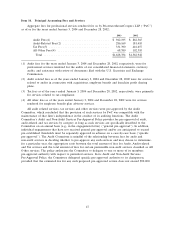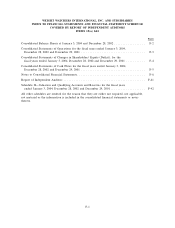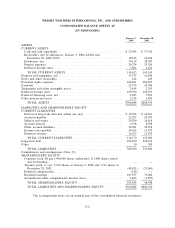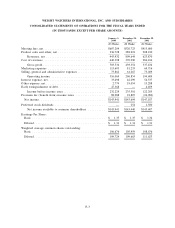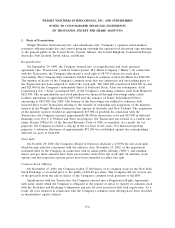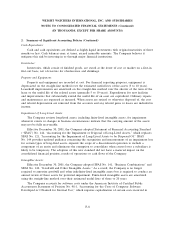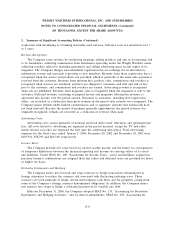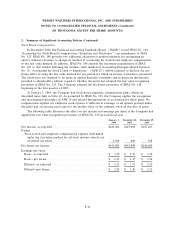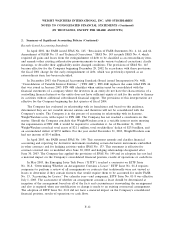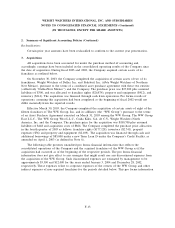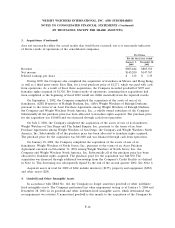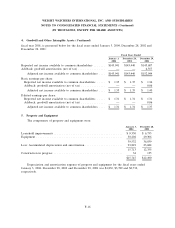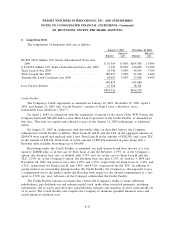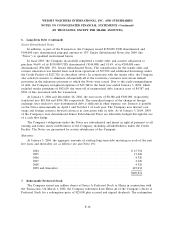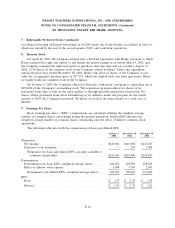WeightWatchers 2003 Annual Report Download - page 63
Download and view the complete annual report
Please find page 63 of the 2003 WeightWatchers annual report below. You can navigate through the pages in the report by either clicking on the pages listed below, or by using the keyword search tool below to find specific information within the annual report.WEIGHT WATCHERS INTERNATIONAL, INC. AND SUBSIDIARIES
NOTES TO CONSOLIDATED FINANCIAL STATEMENTS (Continued)
(IN THOUSANDS, EXCEPT PER SHARE AMOUNTS)
2. Summary of Significant Accounting Policies (Continued)
connection with developing or obtaining internally used software. Software costs are amortized over 3
to 5 years.
Revenue Recognition:
The Company earns revenue by conducting meetings, selling products and aids in its meetings and
to its franchisees, collecting commissions from franchisees operating under the Weight Watchers name,
collecting royalties related to licensing agreements and selling advertising space in and copies of its
magazine. The Company charges non-refundable registration fees in exchange for an introductory
information session and materials it provides to new members. Revenue from these registration fees is
recognized when the service and products are provided, which is generally at the same time payment is
received from the customer. Revenue from meeting fees, product sales, commissions and royalties is
recognized when services are rendered, products are shipped to customers and title and risk of loss
pass to the customer, and commissions and royalties are earned. Advertising revenue is recognized
when ads are published. Revenue from magazine sales is recognized when the magazine is sent to the
customer. Deferred revenue, consisting of prepaid lecture and magazine subscription revenue, is
amortized into income over the period earned. Discounts to customers, including free registration
offers, are recorded as a deduction from gross revenue in the period such revenue was recognized. The
Company grants refunds under limited circumstances and at aggregate amounts that historically have
not been material. Because the period of payment generally approximates the period revenue was
originally recognized, refunds are recorded as a reduction of revenue when paid.
Advertising Costs:
Advertising costs consist primarily of national and local direct mail, television, and spokespersons’
fees. All costs related to advertising are expensed in the period incurred, except for TV and radio
media related costs that are expensed the first time the advertising takes place. Total advertising
expenses for the fiscal years ended January 3, 2004, December 28, 2002 and December 29, 2001 were
$107,931, $78,293 and $66,749, respectively.
Income Taxes:
The Company provides for taxes based on current taxable income and the future tax consequences
of temporary differences between the financial reporting and income tax carrying values of its assets
and liabilities. Under SFAS No. 109, ‘‘Accounting for Income Taxes,’’ assets and liabilities acquired in
purchase business combinations are assigned their fair values and deferred taxes are provided for lower
or higher tax bases.
Derivative Instruments and Hedging:
The Company enters into forward and swap contracts to hedge transactions denominated in
foreign currencies to reduce the currency risk associated with fluctuating exchange rates. These
contracts are used primarily to hedge certain intercompany cash flows and for payments arising from
some of the Company’s foreign currency denominated obligations. In addition, the Company enters
into interest rate swaps to hedge a substantial portion of its variable rate debt.
Effective December 31, 2000, the Company adopted SFAS No. 133, ‘‘Accounting for Derivative
Instruments and Hedging Activities,’’ and its related amendments, SFAS No. 138, ‘‘Accounting for
F-9


